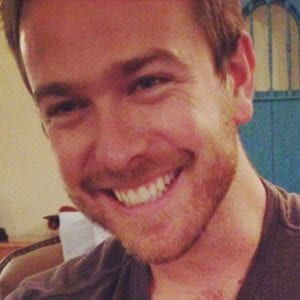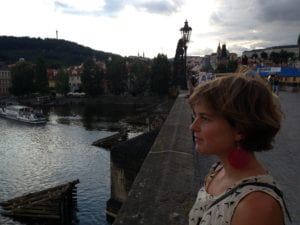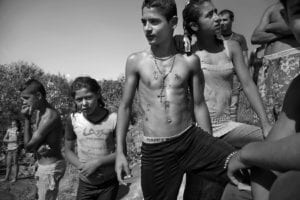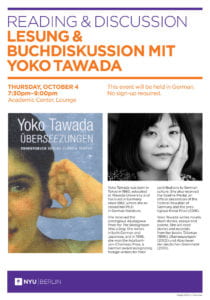 On 18 October, NYU Florence’s La Pietra Dialogues will host Nicholas Boggs from the NYU Department of English. Dr. Boggs will discuss the collaboration between James Baldwin and Yoran Cazac, a French painter and illustrator living in Tuscany. Little Man, Little Man: A Story of Childhood was recently republished to great acclaim by Duke University Press.
On 18 October, NYU Florence’s La Pietra Dialogues will host Nicholas Boggs from the NYU Department of English. Dr. Boggs will discuss the collaboration between James Baldwin and Yoran Cazac, a French painter and illustrator living in Tuscany. Little Man, Little Man: A Story of Childhood was recently republished to great acclaim by Duke University Press.
Global Dimensions
News and notes from across NYU's Campuses and Sites
NYU Prague Alumni – Where are They Now?
Around 5,000 students have spent a semester at NYU Prague over the past 20 years. We contacted a few to find out how their time in Prague affected the trajectory of their lives. Here are their stories:
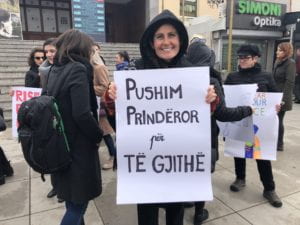 Nicole Farnsworth (Fall, 2001)
Nicole Farnsworth (Fall, 2001)
Seventeen years ago, I was enjoying similar brightly-colored fall leaves while hiking amid castles, the company of new friends and inspiring lectures at NYU in Prague. That fall provided several opportunities that have influenced my life. I heard the very inspiring activist and late President Vaclav Havel, together with the Dalai Lama and other leaders speak at Forum 2000. I learned of the plight of Romani people and went on to research their access to education. Studying women’s rights in transition in post-socialist contexts, as well as the Czech Republic’s EU Accession process provided a useful foundation for my future work.
Perhaps the most life-altering opportunity that studying in Prague provided was proximity to Prishtina. Seventeen years ago this month, I begged my parents for what some may consider an unusual birthday present: a plane ticket to see Kosovo’s first democratic elections. I was fascinated by the United Nation’s experiment in governing post-war Kosovo. If I had not been in Prague, I would not have had such a unique opportunity to witness a (not-yet-recognized) country’s first elections.
After completing my BA, I persistently sought to return to Kosovo. Eventually, I secured a position at a local civil society organization (CSO), supported by the East-West Management Institute (EWMI) with funds from USAID, to strengthen Kosovo CSOs’ advocacy capacities. Since then, I have continued consulting for EWMI, among others, in various civil society support initiatives worldwide.
The vast majority of my last 16 years has been spent with the Kosovo Women’s Network, a network of 138 diverse women’s groups working to further women’s rights. As Program Director / Lead Researcher, I have (co)authored 24 publications on issues related to gender equality, several of which have informed new laws and policies in Kosovo’s state-building process.
In my work, I regularly have drawn from my knowledge gained in Prague, particularly in advocating for Kosovo’s EU Accession process to attend to the needs of both women and men; writing about the position of women in post-socialist Kosovo; and volunteering for Roma rights organizations.
I’m often asked how I first came to Kosovo, and the story always starts with, “I was studying abroad at NYU in Prague…”
Nicole Farnsworth is the program director and lead researcher at the Kosovo Women’s Network.
On a recent research trip to Prague, I returned to the neighborhood where many of us lived during our semester in fall of 2004. I was immediately relieved to discover that our nightly hangout B-52 was exactly as we’d left it, still weirdly decorated with airplane fuselage and parachutes. Nearby Krymska street is a different story. The Shakespeare a Synové bookshop has been replaced with the ultrahip Café v Lese, and the neighborhood is now teeming with
Generation Zed backpackers. Nearby, Žižkov still has its edge, but the rest of Prague feels much more polished these days. The hypercapitalist mall at Nový Smíchov has a 4-D movie theater. Sometimes I feel like I’m in Austria.
But I still can’t let go of Prague. Or is it the other way around? “Prague won’t let you go, the little mother has claws,” wrote the guy on all those souvenir t-shirts. Officially, the reason I return so often is because I’m writing a book about American and Czech writers during the Cold War. The seeds for this project were actually planted at NYU in Prague in 2004, in seminars taught by Tomáš Vrba and Jan Urban. At the time, I had no idea that my semester in Prague would change the trajectory of my life. Now I’m a professor at Arizona State University, which means I have a great excuse to escape the air-conditioned nightmare that is Phoenix in the summertime. But if I’m honest, the book is just an excuse. Prague is where I go to escape what Philip Roth called the “indigenous American berserk.” Prague is where I go to disappear.
Some things don’t change. In 2004, we all stayed up into the early hours to watch two major American events: the ALCS between the Yankees and the Red Sox and the election between John Kerry and George W. Bush. (Both my teams lost.) As I write this, the Yankees and Red Sox are about to face off in the playoffs for the first time since 2004. And we’ve got another election coming up on November 6th, which also happens to fall on the due date of my first child. Back in 2004, I remember buying two books at the bookshop on Krymska: The Man in the High Castle by Philip K. Dick and The Plot Against America by Philip Roth. Maybe my twenty-year-old self was on to something. It’s not too late to teach my future kid to speak Czech.
Brian Goodman got his PhD in American Studies from Harvard University. He is an assistant professor in the Department of English at the Arizona State University and is writing a book about the exchange of literature and culture between the USA and Czechoslovakia during the Cold War.
As a junior at NYU, I studied abroad in Prague. My initial interest in studying there was my mother’s Czech heritage — she grew up in a farming community of Oklahoma Czechs and my grandmother had preserved some knowledge of the language. I fell in love with the city of Prague, and its art and literature, the history of which had never been a subject of study back in the United States. Desiring to learn more, I continued to study Czech language, literature, and visual culture at the MA level at Columbia, and then for my PhD at the University of Michigan, Ann Arbor. I continue to travel to Prague ever year, and even had the opportunity in 2009-2010 to return to NYU in Prague as an employee! The friends on the fabulous staff there are still some of my closest in Prague.
Studying at a big university like NYU, I relished the more intimate environment of the Prague campus, and my experience there as an undergraduate has had an indelible mark on my life and career since.
Meghan Forbes earned a PhD from the University of Michigan, Ann Arbor with dissertation about the avant-garde in interwar Prague and Brno. She is now at the Museum of Modern Art in New York as a Contemporary and Modern Art Perspectives Fellow for Central and Eastern Europe.
Callum Voge (Fall, 2012)
As a student of international politics, I was intellectually attracted to the Czech Republic’s unique political history and transition to democracy. Having grown up in China, I especially wanted to learn about the differing experiences of communism in China and in Europe.
While at NYU Prague, I interned at a non-profit media organization called Project Syndicate where I produced content for the organization’s social media channels and conducted research on international media markets. After graduating from NYU, I had the opportunity to return to Project Syndicate for a full time position. I have now been working at Project Syndicate for four years and manage the organization’s external media partnerships in 50 countries.
Prague has always been a special place to me. The concentration of non-profit institutions and the large foreign community in Prague creates a unique environment – at times Prague feels like a very local city while at other times very global. Prague’s increasing internationalization over the past years has made it an exciting place to live. You only need to look at the city’s food scene to see the change. When I first moved from New York I could only dream of the restaurant diversity that I had known. Now I can easily have Indonesian food one night, Venezuelan another, and Georgian the next. The feeling that Prague is moving in the right direction makes it an exciting time to be here.
Callum Voge is the Senior Global Relations Manager at Project Syndicate, where he is also the internship mentor to current NYU Prague students.
Kieran Kesner (Spring, 2013)
It wasn’t the first time I visited Prague and that’s probably why I decided to return. Prague represents the crossroads between the quintessential Western European study abroad experience and the Eastern European culture, which entwined with my own family history, so I was eager to explore.
Studying in Prague was as much a period of self-realization as it was an opportunity to live abroad and immerse myself in a different culture. It was at this intersection that I began to explore what inspired me most as a photographer, learning about and sharing other peoples stories. While studying abroad, I found those stories in the often misunderstood and much maligned Roma people, known to the outside world as Gypsies. Through significant research on my own and mentorship from local NYU professor, Ivana Dolezalova, I began traveling around the country on weekends and school vacations to spend time with Roma and experience first hand, their rich culture, and kind generosity. While prejudice and discrimination is a centuries-old narrative for the Roma, my personal experience strongly confronted the oppressive counter-narrative I was hearing. It was through this experience that I learned how the camera can provide a unique opportunity to interact and connect with people, often despite language barriers, that few other mediums share.
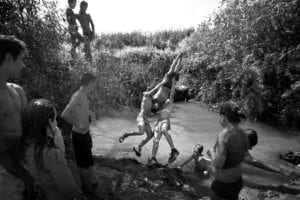 Today, I continue to work full time as a photojournalist and photographer/videographer for newspapers and magazines around the world as well as for commercial, corporate, non-profit and lifestyle brands. In the last year alone, I have traveled to over 20 countries for work assignments, feeding off a spark that began when I chose to study at NYU Prague, and which I hope will continue for many years to come.
Today, I continue to work full time as a photojournalist and photographer/videographer for newspapers and magazines around the world as well as for commercial, corporate, non-profit and lifestyle brands. In the last year alone, I have traveled to over 20 countries for work assignments, feeding off a spark that began when I chose to study at NYU Prague, and which I hope will continue for many years to come.
Kieran Kesner is an award-winning photographer, videographer and visual storyteller based in Boston. His work has been published in numerous publications including the Boston Globe, The New Yorker, the Guardian, and the Wall Street Journal.
Short takes
You might remember the band “With Snack” which performed regularly in the Osadni basement during the spring 2014 semester. Former music students Aviv Goldgeier, Matti Dunietz, and Evan Lane are still in the progressive R&B band, which has been renamed Valipala and is based in New York City. They released their debut digital album, Mango City in 2017 (available at https://valipala.bandcamp.com/album/mango-city) and are releasing a new single on October 26, 2018.
One of the most well-known NYU Prague alumni is Ari Leff (Spring 2015)- now known as Lauv – a singer/songwriter whose single I Like Me Better has had over 100 million views on Youtube. Last June he was ranked as number one on Billboard’s Emerging Artists chart.
Another NYU Prague celebrity is Camila Mendes (Fall 2014), an actress who plays Veronica Lodge in the TV teen drama Riverdale, for which she won the she won the Teen Choice awards in 2017. She recently acted in the comedy film The Stand In, to be released in 2019.
Christina Ng (Spring 2009) is an editorial producer for CBS news, where she’s been employed since 2011. She’s also worked for CBS as a reporter and as assistant to anchor Diane Sawyer.
Hunter Nolan, (Spring 2012), was the cinematographer on Before the Flood, a climate change documentary directed by Fisher Stevens, produced by Leonardo DiCaprio and executive produced by Martin Scorsese. He also worked on the award winning documentaries Before the Flood, Sky Ladder and Racing Extinction.
In 2017, Kim Pham (Spring 2012 ) – entrepreneur and founder of Oxtale – was recognized as a Forbes 30 under 30 honoree for her work at Frontline, building VC platforms.
Allan Peng (Spring, 2016), who was active in the PragueCast and Prague Wandering blog, is now a producer at CBS News Radio, working on an upcoming podcast about polling, as well as other digital audio content.
Melanie Weisner, who studied vocal performance at NYU Prague in 2006, is now one of the top American female poker players. As of 2016, Weisner is ranked 38th on the Women’s All Time tournament money list.
NYU Florence Hosts Event on Feminism & Intersectionality in the Arts
 On Thursday October 11, NYU Florence will host an event on Feminism & Intersectionality in the Arts.
On Thursday October 11, NYU Florence will host an event on Feminism & Intersectionality in the Arts.
Feminist theory has been criticized for failing to consider the intersections among patriarchy and other forms of inequality in social and political relations. The term intersectionality arose out of critical race theory to propose an analysis of “relationships among multiple dimensions and modalities of social relations and subject formations” (Kimberlé Crenshaw). Expanding on the conversation started last year in the conference Resetting the Table: A Symposium on Feminist Art and Herstory we will explore the intersections of feminism with various other fluid and multidimensional markers and aspects of identity—including race, class, and gender identity – in approaches to art history, curating and practice, and the opening of opportunity in other institutional cultural spaces. We will begin with a discussion of the legal theory of intersectionality with NYU Law Professor Paulette Caldwell followed by a discussion with art historians Kalia Brooks and Maria Antonia Rinaldi, curator of the Elizabeth Sackler Center for Feminist Art at the Brooklyn Museum Carmen Hermo and artists Patricia Cronin and Lerato Shadi.
NYU Sydney’s Mark Eels on Balancing the BRI
 This article comes to us from Mark Eels, NYU Sydney’s Operations & Communications Coordinator, and was originally published in Australia as a China Matters Young Professionals Stance .
This article comes to us from Mark Eels, NYU Sydney’s Operations & Communications Coordinator, and was originally published in Australia as a China Matters Young Professionals Stance .
Balancing the BRI
The Belt and Road Initiative (BRI), formerly referred to as One Belt One Road or 一带一路, was a concept borne, on the one hand, to remedy structural inefficiencies, local debt and rampant overcapacity, and, on the other, as parallel trade architecture to counter the Trans-Pacific Partnership (TPP) and bolster the standing of the People’s Republic of China (PRC).
The BRI represents a latent microcosm of our larger engagement strategy with the PRC. However, Australia is yet to formally endorse the BRI. Moreover, domestic public opinion about Australia’s involvement is pessimistic. So are we at risk of missing the boat?
While BRI has announced five major goals of policy coordination, facility connectivity, unimpeded trade, financial integration and people-to-people bonds, the cornerstone, at least for now, is infrastructure development. BHP Billiton’s BRI project database appraises investment related to power, railways, pipelines and transport as accounting for 70 percent of aggregate spending with the remainder related to new economic zones, industrial parks, refineries, plants and public buildings. Estimates for PRC investment ranging to as high as 8 trillion USD. As a result, project announcements revive a similar sentiment to that experienced during the PRC’s 2008 stimulus package, whereby capital largely flowed downstream to infrastructure projects, heavily reliant on Australian resources.
Major Australian ore producers Rio Tinto, BHP, and Fortescue are primed to benefit from this transcontinental appetite for infrastructure investment boasting entrenched sectoral structural power, massive break even advantages and vessel roundtrip times around half that of Brazilian counterparts. Stubborn PRC domestic ore production is finally falling, with last month’s output the lowest for a non-winter period since 2008.
There are, however, major risks associated with BRI.
As Future Risk’s Tristan Kenderdine notes, BRI projects and international capacity cooperation behind them ‘cynically export China’s industrial policy, circumventing the established trade and investment architecture … As China domestically struggles to contain the local government debt built up, export of the investment-driven industrial model, which is what ICC [International Capacity Cooperation] represents, will inevitably export the lax banking standards and endogenous risk to other middle-income countries which do not have the financial infrastructure to survive a collapse.’ More bluntly, as he revealed to me in a novel manner ‘If you are exposed to China’s state capital then you are exposed to China’s local government debt and no one wants to know how that sausage is made’.
Peter Cai has demonstrated feasibility apprehensions with BRI projects. Cai quotes Andrew Collier, Managing Director of Orient Capital Research, ‘It is pretty clear that everyone is struggling to find decent projects. They know it’s going to be a waste and don’t want to get involved, but they have to do something’.
PRC projects are also less open to local and international participation, ‘out of all contractors participating in Chinese-funded projects within the Reconnecting Asia database, 89 percent are Chinese companies … In comparison, out of the contractors participating in projects funded by the multilateral development banks, 29 percent are Chinese, 40.8 percent are local, and 30.2 percent are foreign.’
So how does Australia intend to proceed? Should it be business as usual and are we content to again be seen as the dustbowl of the PRC, or can we learn to more broadly balance the benefits of BRI engagements while mitigating exposure to capital risks?
Should BRI infrastructure projects prove fruitful, there will be new industrial clusters in East Africa, Central Asia and the Middle East all needing resources and iron ore for steel manufactures, along with industry expertise. 139 ASX companies are in 34 countries across Africa, making Australia the largest international miner on the continent. Government and industry level dialogue with bodies such as the Australia-Africa Minerals & Energy Group need to be increased to include more participants looking to understand opportunities and operational risk.
The Australian government at all levels should foster new relations with emerging economies along BRI to capitalise on the downstream effects of BRI. Examples include the 2014 Memorandum of Understanding (MoU) with the Common Market for Eastern and Southern Africa (COMESA) that focuses on technology for mining, energy and agriculture.
Australia should persistently leverage its positions in institutions such as the Asian Infrastructure Investment Bank to create strong risk culture, strengthen governance frameworks and ensure opportunities for Australian contractors to bid under open procurement models. Increasing transparency and accountability will open the door for Australian expertise in services such as project management, engineering consultancy, and financial and legal services.
As BRI facilitates further RMB internationalization, Sydney, as 1 of 20 global official offshore RMB centers should boost its capacity to become a hub for RMB cash and security settlement in the Asia Pacific.
Australia needs to think more broadly about its relationship with the PRC by developing a multidimensional view inclusive of related economies situated along the PRC-led BRI.
NYU Berlin Hosts Reading & Discussion with Yoko Tawada
She received the prestigious Akutagawa Prize for The Bridegroom Was a Dog. She writes in both German and Japanese, and in 1996, she won the Adalbert-von-Chamisso Prize, a German award recognizing foreign writers for their contributions to German culture. She also received the Goethe-Medal, an official decoration of the Federal Republic of Germany and the prestigious Kleist Prize (2016). Yoko Tawada writes novels, short stories, essays and poems. She will read stories and excerpts from her books Talisman (1996), Überseezungen! (2002) und Abenteuer der deutschen Grammatik (2010).
This event will be held in German.
NYU Paris Introduces ParisCast
 NYU Paris introduces ParisCast, the first broadcast network at NYU’s Global Academic Center in Paris.
NYU Paris introduces ParisCast, the first broadcast network at NYU’s Global Academic Center in Paris.
Listen to the first ParisCast here and stay turned for future episodes!
NYU Sydney’s Fran Molloy on Australia’s Population Reaching 25 Million Two Decades Earlier than Predicted
AUSTRALIA’S POPULATION HITS 25 MILLION EARLIER THAN EXPECTED
By Fran Molloy, NYU Sydney Lecturer in Journalism
 On August 7, Australia’s population reached 25 million, more than two decades faster than predicted.
On August 7, Australia’s population reached 25 million, more than two decades faster than predicted.
Recently, the Australian Bureau of Statistics population clock – which adds another Australian every 1 minute and 23 seconds – rolled over to exactly 25 million.
It’s a significant benchmark, particularly when as recently as 2002, Australia’s population was predicted to climb from 19.6 million in 2002, to 25.3 million in 2042.
Instead, Australia’s already at 25 million, more than two decades earlier than expected; and if current trends continue, will likely exceed 30 million by 2030.
“When population grows rapidly, it makes it more likely that you will have further growth in the near future, because you have a younger and more fertile population,” says Professor Nick Parr, from Macquarie’s Centre for Workforce Futures.
He points out that population growth is complex; while migration has played a huge role in for Australia’s fast growth over the last couple of decades, factors like a strong economy pre-2008 and delayed childbearing also contributed to a “baby bump” in the early years of this century.
Students + Kiwis + holiday workers + expats + babies = 25 million
In 2017, net migration accounted for 62 per cent of our population increase. “That number includes international students as well as temporary workers, working holiday makers, New Zealanders and returning expatriates,” says Parr.
With house prices recently spiralling in major cities and complaints of traffic congestion and overdevelopment growing louder, rapid population growth is generally unpopular among Australians.
But there are advantages, Parr says – chief among them that population growth due to immigration both supports our ageing residents – and slows the overall rate of ageing of our population.
“When we have more people working and contributing taxes, the costs of population ageing are spread more widely,” he says.
He says that a more pressing issue for Australia than population growth, is its distribution. “Geographically, our population growth is very heavily concentrated in the major cities, which is the key factor influencing congestion and housing issues.”
What’s next? “Our population will continue to grow, and we need to plan for that as best we can,” he says. “We need to look further into the future to ensure today’s children are educated and trained in areas that would be gainfully used in the labour market, so they help defray the costs of population aging and contribute to tax dollars.”
This article has been republished with the permission of The Lighthouse, Macquarie University’s multimedia news platform.
NYU Abu Dhabi Launches Fikret Science Club to Initiate Conversations on Science in Abu Dhabi
 NYU Abu Dhabi’s Center for Genomics and Systems Biology (CGSB) is organizing an ongoing series of informal public gatherings through its newly launched Fikret Science Club. Driven towards promoting an understanding of the scientific world to the Abu Dhabi community, the Club will explore various topics under certain themes such as: conservation of cultural heritage through science, biological rhythms and mood, climate change and environmental adaptation, and science in society, among others.
NYU Abu Dhabi’s Center for Genomics and Systems Biology (CGSB) is organizing an ongoing series of informal public gatherings through its newly launched Fikret Science Club. Driven towards promoting an understanding of the scientific world to the Abu Dhabi community, the Club will explore various topics under certain themes such as: conservation of cultural heritage through science, biological rhythms and mood, climate change and environmental adaptation, and science in society, among others.
Launching on September 25, 2018, at 7pm, these two-hour long discussions will take place every month at LARTE Restaurant in Manarat Al Saadiyat, Abu Dhabi. Members of the CGSB will lead the monthly gatherings, including the Associate Director of CGSB Operations at NYU Abu Dhabi Enas Qudeimat, and Manager of Administration for the Provost at NYU Abu Dhabi Tiffany Kilfeather. The first talk is entitled A hydrogen atom’s view of ancient mummies and art forgers, and will be led by Assistant Professor of Chemistry at NYU Abu Dhabi Maria Baias.
Fikret Science Club is open to both established science enthusiasts and those curious to learn more.
This post comes to us from NYU Abu Dhabi. The original can be found here.
NYU Florence Considers – Can Creativity Change the World?
O n 24 September, NYU Florence will host a dialogue with Adama Sanneh, Co-Founder and COO of the Moleskin Foundation.
n 24 September, NYU Florence will host a dialogue with Adama Sanneh, Co-Founder and COO of the Moleskin Foundation.
The Moleskine Foundation is a non-profit organization that believes that quality education is key to producing positive change in society and driving our collective future. Focusing on communities affected by cultural and social deprivation, the Foundation is committed to providing youth with unconventional educational tools and experiences that help foster critical thinking, creativity and life-long learning. With a special focus on Africa and its diaspora, the Foundation works closely with local organizations to fund, support and co-create a wide range of distinctive initiatives. Sanneh will present the new strategy of the Foundation and its main initiatives with a specific focus on the role that creativity and art can play in social transformation.
Adama graduated in Linguistic and Cultural Mediation from the University of Milan, he worked for several years in East Africa on rural development and humanitarian emergency programs. He obtained a Master in Public Management (MPM) from the Bocconi School of Management and a Master of Business Administration (MBA) from the University of Geneva. After graduating, he worked as a management and strategy consultant for various public and not-for-profit organizations among which the United Nations, in education, social entrepreneurship and innovation. As Co-Founder and COO of the Moleskine Foundation, he is committed to promoting and advocating a more profound understanding of the African continent, focusing on the role that art and culture can play in social change.
NYU Shanghai Professor Zhang Zheng to Head Amazon’s New AI Lab in Shanghai
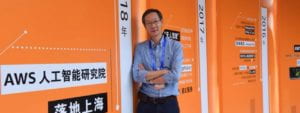 NYU Shanghai Professor of Computer Science Zhang Zheng has been appointed Director of Amazon Web Services’ (AWS) newly-opened Shanghai Artificial Intelligence Lab, where he will lead the company’s advanced research and development of deep learning.
NYU Shanghai Professor of Computer Science Zhang Zheng has been appointed Director of Amazon Web Services’ (AWS) newly-opened Shanghai Artificial Intelligence Lab, where he will lead the company’s advanced research and development of deep learning.
AWS made the announcement on September 17 at the 2018 World Artificial Intelligence Conference in Shanghai, shortly after Zhang, a U.S. citizen, became the first foreigner to receive a work permit from the Pudong government allowing him to hold simultaneous positions at Amazon and NYU Shanghai.
An award-winning expert in the theories and practices of large-scale distributed computing and its intersection with machine learning, Zhang held significant positions at Microsoft and Hewlett Packard prior to beginning his career at NYU Shanghai in 2013.
At Amazon, Zhang, who will maintain his appointment at NYU Shanghai but take a leave of absence from his university duties, plans to build a lab that researches natural language processing with a special focus on Chinese. He also hopes to engage and develop an open-source deep learning ecosystem and advise Chinese customers on machine learning and AI adoption.
“I’m honored to join the AWS AI Lab Shanghai, where, together with some of the world’s brightest minds, we will have the opportunity to spur innovation, make technologies easy, fast, and useful for Chinese organization of all sizes,” Zhang said.
“One of the areas I will emphasize is fundamental research via a lab with global culture, and do so in tight collaboration with major universities in Shanghai, including NYU Shanghai,” he added.
Earlier this month, the Exit-Entry Administration of the Pudong Public Security Bureau, as part of its efforts to attract high-end foreign talent, issued Zhang its first-ever work permit allowing foreigners to work part-time in the Shanghai Free Trade Zone. NYU Shanghai Chancellor Yu Lizhong applauded the new policy.
“As a research university, NYU Shanghai encourages its faculty to conduct further research on cutting-edge frontiers and help cultivate global talent,” he said. “The fact that Professor Zhang can now play a key role in the research and development of a leading industry is of great value to the university, enabling us to strengthen our partnerships with leading companies.”
Professor Zhang is not the first NYU Shanghai community member to take advantage of the government’s efforts to clear hurdles and enable more foreign citizens, particularly innovators and entrepreneurs, to work in Shanghai. Last June, Tyler Rhorick ‘17 became the first international student to obtain a work permit under a new policy allowing foreign graduates of Chinese-accredited universities such as NYU Shanghai to obtain visas to work in Shanghai’s Free Trade Zone. Rhorick now works in NYU Shanghai’s Student Life Office.
Another alumna, Lathika Chandra Mouli ‘17, an Electrical Engineering major, obtained a new “Talent Visa” from the Shanghai Yangpu district that is reserved for recent college graduates employed by startups or Fortune 500 companies. Mouli joined Energo Labs, a blockchain startup, as a project specialist after graduation.
This post comes to us from NYU Shanghai. The original can be found here.
